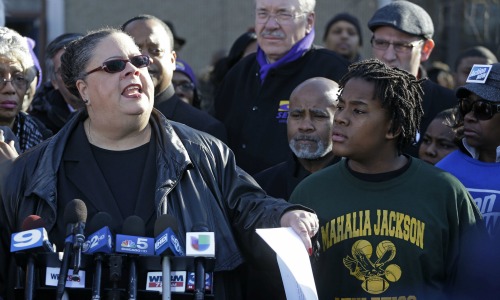 Chicago Teachers Union President Karen Lewis speaks outside the Mahalia Jackson Elementary School in Chicago, Thursday, March 21, 2013, about the planned closing of public schools. The city of Chicago began informing teachers, principals and local officials Thursday about which public schools it intends to close under a contentious plan that opponents say will disproportionately affect minority students in the nation’s third largest school district. (AP Photo/M. Spencer Green)
Chicago Teachers Union President Karen Lewis speaks outside the Mahalia Jackson Elementary School in Chicago, Thursday, March 21, 2013, about the planned closing of public schools. The city of Chicago began informing teachers, principals and local officials Thursday about which public schools it intends to close under a contentious plan that opponents say will disproportionately affect minority students in the nation’s third largest school district. (AP Photo/M. Spencer Green)
Chicago Public Schools officials ended months of speculation when they released the list of 54 schools the city plans to close, but the pushback against Mayor Rahm Emanuel and his schools chief is likely just starting to ramp up.
As word of the schools on the long-awaited closings list trickled out Thursday, parents, teachers and community members — some furious, some in tears — vowed to fight the closings. One group took a bus of people to protest in front of the homes of school board members, and some parents spoke of a lawsuit. The Chicago Teachers Union already had scheduled a mass protest march through downtown for next week.
“We are the City of Big Shoulders and so we intend to put up a fight,” union President Karen Lewis said. “We don’t know if we can win, but if you don’t fight, you will never win at all.”
Emanuel and schools CEO Barbara Byrd-Bennett say the closures are necessary because too many Chicago Public School buildings are half-empty, with 403,000 students in a system that has seats for more than 500,000. But opponents say the closures will further erode troubled neighborhoods and endanger students who may have to cross gang boundaries to attend school. The schools slated for closure are all elementary schools and are overwhelmingly black and in low-income neighborhoods.
About 30,000 students will be affected by the plan, with about half that number moving into new schools.
CPS officials say money being spent to keep underused schools open could be better used to educate students elsewhere as the district deals with a $1 billion budget deficit. The district says it will invest money to improve schools that are welcoming new students. The funds will be used to add better technology, air conditioning, tutoring services, increased security and other services. CPS says it also will ensure every school has a library and that students no longer are learning in dilapidated buildings.
“We know this is going to be difficult, but we believe it’s the right thing to do,” said CPS spokeswoman Becky Carroll.
“I’m sure any parent would stand up and say they want a better education for their child. And in order for that to happen, we have to do this and move on.”
Carroll said public hearings will be scheduled over the next two months, and CPS officials will meet one-on-one and in small groups with parents to make sure they understand what’s happening.
Chicago officials have moved to close schools in the past, but never anywhere near the number designated at one time by the Emanuel administration. Former Mayor Richard M. Daley’s administration spread school closings over a number of years. CPS, the nation’s third-largest school district, now has 681 schools.
Chicago is among several major U.S. cities, including
Philadelphia, Washington and Detroit, to use mass school closures to reduce costs and offset declining enrollment. Detroit has closed more than 130 schools since 2005, including more than 40 in 2010 alone.
The issue has again pitted Emanuel against the Chicago Teachers Union, whose 26,000 members went on strike early in the school year, idling students for seven days. Chicago aldermen and other lawmakers also have blasted the plan.
Among the critics is Eular Hatchett, who lives in the violence-plagued neighborhood of North Lawndale and walks her 13-year-old nephew DaVontay Horace to school.
“Our parents know about this area,” she said. “They don’t know about those other areas. If they send him way north or way south, I’m not going to do that. It’s too dangerous.”
Because some schools have more than one building, a total of 61 structures will be closed. In addition to the closures, students at 11 other schools will be “co-located” with existing schools. Six schools have been targeted for academic interventions known as “turnaround.”
The vast majority of the 54 schools are in overwhelmingly black neighborhoods that have lost residents in recent years. The city’s black population dropped 17 percent in the last census as African-Americans moved out to the suburbs and elsewhere. The other few schools are majority Hispanic or mixed black and Hispanic. Overall, 91 percent of Chicago public school students are minorities.
CPS says the plan will save the district $560 million over 10 years in capital costs and an additional $43 million per year in operating costs.


